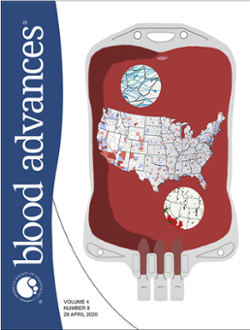Data Analysis Offers Closer Look at US Blood Supply Chain
MBP research team used geospatial mapping tools, economic sensitivity tests, and survival time analysis in the study
A research team from Northwestern Engineering’s Master of Biotechnology Program (MBP) conducted a comprehensive data analysis of the US blood supply chain, uncovering insights into the geographical prevalence and economic costs of blood recalls.
Blood and blood-based products are a limited resource dependent on voluntary donations. While blood donation rates are in decline, demand for blood products are increasing in order to provide medical care for aging populations in developed countries. Recalled blood products, deemed unusable due to safety or potency violations, risk spurring blood shortages and economic losses, further straining the blood supply network.
 “Blood products that are recalled because of safety or potency deviations can lead to adverse health events, but very little is known about the cause and impact of blood recall events,” said Arthur Felse, associate professor of instruction and assistant director of research in MBP at the McCormick School of Engineering, who led the research. “Developing systematic approaches to mitigate blood product recalls is a challenge. Our analysis could help scientists and policy makers develop superior recall mitigation and suppression strategies in the future.”
“Blood products that are recalled because of safety or potency deviations can lead to adverse health events, but very little is known about the cause and impact of blood recall events,” said Arthur Felse, associate professor of instruction and assistant director of research in MBP at the McCormick School of Engineering, who led the research. “Developing systematic approaches to mitigate blood product recalls is a challenge. Our analysis could help scientists and policy makers develop superior recall mitigation and suppression strategies in the future.”
To assess the impact of blood recall events, the researchers analyzed data extracted from FDA weekly enforcement reports, the FDA blood product establishments database, and AABB’s (formerly known as the American Association of Blood Banks) blood utilization survey.
Using a combination of geospatial mapping tools, economic sensitivity tests, and survival time analysis, the researchers were able to draw insights into recall prevalence and causes of time and monetary losses attributed to blood recalls.
 The group found issues related to donor screenings and the quality of donated blood accounted for nearly 60 percent of the total reported recall events. Sterility deviations and contamination, while accounting for only 4 percent of recalls, were found to be particularly difficult to resolve and resulted in significant monetary losses. Overall, blood recalls resulted in $18 million in economic losses and 2.8 million days spent on resolution.
The group found issues related to donor screenings and the quality of donated blood accounted for nearly 60 percent of the total reported recall events. Sterility deviations and contamination, while accounting for only 4 percent of recalls, were found to be particularly difficult to resolve and resulted in significant monetary losses. Overall, blood recalls resulted in $18 million in economic losses and 2.8 million days spent on resolution.
The researchers also pinpointed geographic “hotspots” where blood recall events most often originated, such as regions in southern California, Arizona, and northern Florida. High population centers like New York City, Chicago, and San Francisco had a greater distribution density of recalled blood products.
“We didn’t observe the most severe Class I recall events, which speaks to the strength and robustness of the blood supply chain in the United States,” Felse said. “However, the high prevalence of recall events originating from a few geographic regions negatively impacts the overall supply chain.”
Based on their findings, the researchers developed a new parameter, recall event density (RED), to estimate the normalized prevalence of blood recall events at the county level.
“Better donor screening procedures, rigorous sterility requirements, improved containment methods, and recall mitigation in high prevalence regions could all help foster a more robust blood supply chain,” Felse said. “Studies like these can encourage informed discussion on where and how best to focus efforts to address the prevailing challenges of the US blood supply network.”
A paper outlining the team’s work, titled “A Cross-Sectional Study of Prevalence, Distribution, Cause, and Impact of Blood Product Recalls in the United States,” was published April 28 in the journal Blood Advances and was featured on the issue’s cover. MBP students Ibrahim Alqemlas, Sneha Shankar, and Winode Handagama were the paper’s coauthors.

